Haifan Yin
Wideband channel sensing with holographic interference surfaces
May 30, 2025Abstract:The Holographic Interference Surface (HIS) opens up a new prospect for building a more cost-effective wireless communication architecture by performing Radio Frequency (RF) domain signal processing. In this paper, we establish a wideband channel sensing architecture for electromagnetic wave reception and channel estimation based on the principle of holographic interference theory. Dute to the nonlinear structure of holograms, interferential fringes composed of wideband RF signals exhibit severe self-interference effects in the time-frequency domain, which are inherently resistant to the classical signal processing tools. To overcome the self-interference, we propose a holographic channel recovery method, which analyzes the time-domain variation of holograms from a geometrical perspective and constructs an inverse mapping from wideband holograms to object waves. Based on the Wirtinger partial derivative and Armijo condition, we then develop a wideband hologram-based maximum likelihood (WH-ML) estimation method for estimating the channel state information (CSI) from holograms. We also propose a geometric rotation-based object wave sensing (GROWS) algorithm to address the complicated computation of ML estimation. Furthermore, we derive the Cram\'er-Rao lower bound (CRLB) for investigating the achievable performance of wideband holographic channel estimation. Simulation results show that under the wideband channel sensing architecture, our proposed algorithm can accurately estimate the CSI in wideband scenarios.
Design and Prototyping of Filtering Active STAR-RIS with Adjustable Power Splitting
Jan 19, 2025



Abstract:Reconfigurable Intelligent Surfaces (RISs) have emerged as a transformative technology for next-generation wireless communication systems, offering unprecedented control over electromagnetic wave propagation. In particular, Simultaneously Transmitting and Reflecting RISs (STAR-RISs) have garnered significant attention due to their full-space coverage. This paper presents an active STAR-RIS, which enables independent control of both transmission and reflection phases and features out-of-band harmonic suppression. Unlike the traditional passive RIS, the proposed design integrates active amplification to overcome the inherent passive losses, significantly enhancing signal strength and system performance. Additionally, the system supports dynamic power allocation between transmission and reflection modes, providing greater flexibility to meet diverse communication demands in complex propagation environments. The versatility of the design is further validated by extending the Radar Cross Section (RCS)-based path loss model to the STAR-RIS. This design improves efficiency, flexibility, and adaptability, offering a promising solution for future wireless communication systems, particularly in scenarios requiring simultaneous control of transmission and reflection signals.
Movable Superdirective Pairs: A Phase Shifter-Free Approach to mmWave Communications
Dec 31, 2024



Abstract:In this letter, we propose a novel Movable Superdirective Pairs (MSP) approach that combines movable antennas with superdirective pair arrays to enhance the performance of millimeter-wave (mmWave) communications on the user side. By controlling the rotation angles and positions of superdirective antenna pairs, the proposed MSP approach maximizes the received signal-to-noise ratio (SNR) of multipath signals without relying on phase shifters or attenuators. This approach addresses the limitations of traditional superdirective antennas, which are typically restricted to the endfire direction and suffer from reduced scanning bandwidth and increased complexity. An efficient algorithm based on alternating optimization and the gradient projection method is developed to solve the non-convex optimization problem of antennas' joint rotating positioning. Simulation results demonstrate that the MSP approach achieves significant performance gains over fixed-position array (FPA) employing Maximum Ratio Combining (MRC), while reducing system complexity and hardware costs.
A Block Quantum Genetic Interference Mitigation Algorithm for Dynamic Metasurface Antennas and Field Trials
Oct 21, 2024



Abstract:This paper proposes a quantum algorithm for Dynamic Metasurface Antennas (DMA) beamforming to suppress interference for an amplify-and-forward relay system in multi-base station environments. This algorithm introduces an efficient dynamic block initialization and overarching block update strategy, which can enhance the Signal-to-Interference-plus-Noise Ratio (SINR) of the target base station (BS) signal without any channel information. Furthermore, we built a relay system with DMA as the receiving antenna and conducted outdoor 5G BS interference suppression tests. To the best of our knowledge, this is the first paper to experiment DMA in commercial 5G networks. The field trial results indicate an SINR improvement of over 10 dB for the signal of the desired BS.
Modeling, Design, and Verification of An Active Transmissive RIS
Oct 16, 2024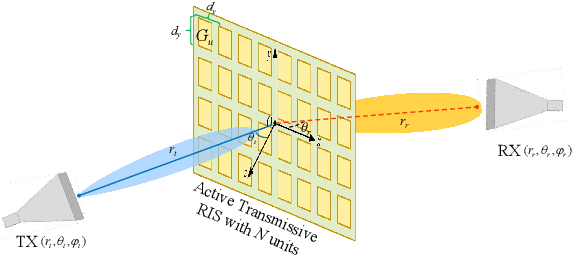
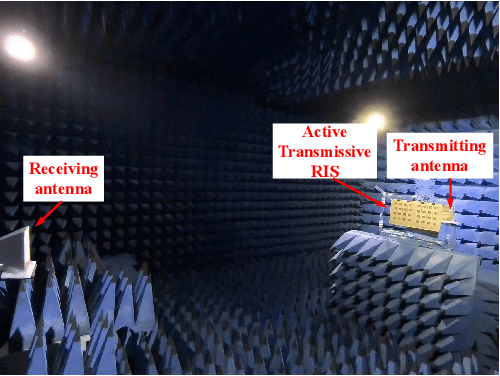
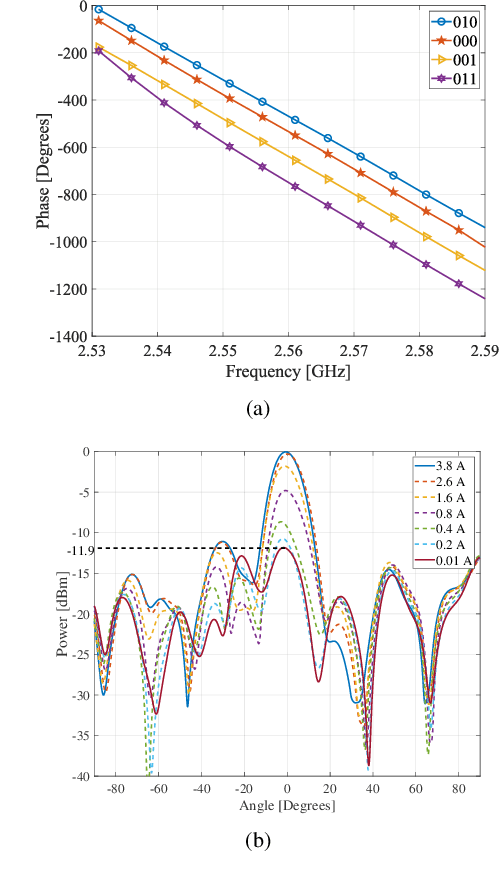
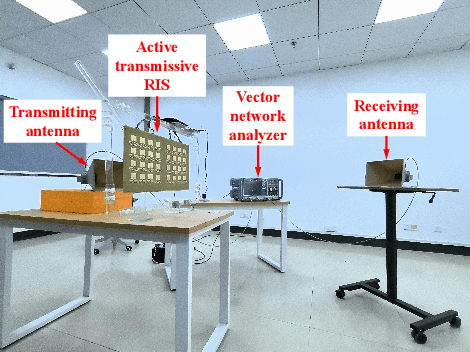
Abstract:Reconfigurable Intelligent Surface (RIS) is a promising technology that may effectively improve the quality of signals in wireless communications. In practice, however, the ``double fading'' effect undermines the application of RIS and constitutes a significant challenge to its commercialization. To address this problem, we present a novel 2-bit programmable amplifying transmissive RIS with a power amplification function to enhance the transmission of electromagnetic signals. The transmissive function is achieved through a pair of radiation patches located on the upper and lower surfaces, respectively, while a microstrip line connects two patches. A power amplifier, SP4T switch, and directional coupler provide signal amplification and a 2-bit phase shift. To characterize the signal enhancement of active transmissive RIS, we propose a dual radar cross section (RCS)-based path loss model to predict the power of the received signal for active transmissive RIS-aided wireless communication systems. Simulation and experimental results verify the reliability of the RIS design, and the proposed path loss model is validated by measurements. Compared with the traditional passive RIS, the signal power gain in this design achieves 11.9 dB.
Partial reciprocity-based precoding matrix prediction in FDD massive MIMO with mobility
Oct 06, 2024Abstract:The timely precoding of frequency division duplex (FDD) massive multiple-input multiple-output (MIMO) systems is a substantial challenge in practice, especially in mobile environments. In order to improve the precoding performance and reduce the precoding complexity, we propose a partial reciprocity-based precoding matrix prediction scheme and further reduce its complexity by exploiting the channel gram matrix. We prove that the precoders can be predicted through a closed-form eigenvector interpolation which was based on the periodic eigenvector samples. Numerical results validate the performance improvements of our schemes over the conventional schemes from 30 km/h to 500 km/h of moving speed.
A Superdirective Beamforming Approach based on MultiTransUNet-GAN
Aug 27, 2024Abstract:In traditional multiple-input multiple-output (MIMO) communication systems, the antenna spacing is often no smaller than half a wavelength. However, by exploiting the coupling between more closely-spaced antennas, a superdirective array may achieve a much higher beamforming gain than traditional MIMO. In this paper, we present a novel utilization of neural networks in the context of superdirective arrays. Specifically, a new model called MultiTransUNet-GAN is proposed, which aims to forecast the excitation coefficients to achieve ``superdirectivity" or ``super-gain" in the compact uniform linear or planar antenna arrays. In this model, we integrate a multi-level guided attention and a multi-scale skip connection. Furthermore, generative adversarial networks are integrated into our model. To improve the prediction accuracy and convergence speed of our model, we introduce the warm up aided cosine learning rate (LR) schedule during the model training, and the objective function is improved by incorporating the normalized mean squared error (NMSE) between the generated value and the actual value. Simulations demonstrate that the array directivity and array gain achieved by our model exhibit a strong agreement with the theoretical values. Overall, it shows the advantage of enhanced precision over the existing models, and a reduced requirement for measurement and the computation of the excitation coefficients.
Transforming Time-Varying to Static Channels: The Power of Fluid Antenna Mobility
Aug 09, 2024

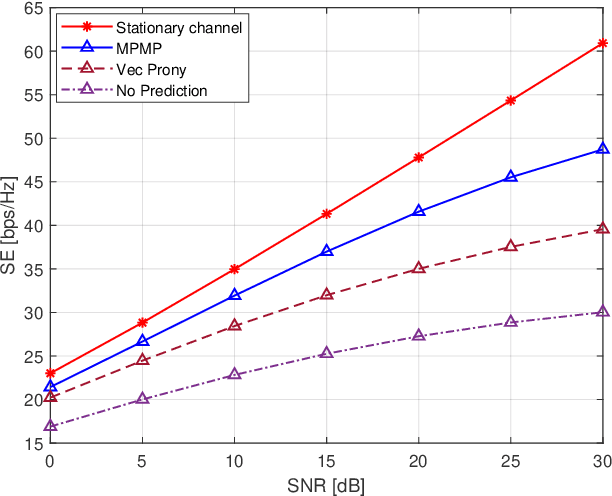

Abstract:This paper addresses the mobility problem with the assistance of fluid antenna (FA) on the user equipment (UE) side. We propose a matrix pencil-based moving port (MPMP) prediction method, which may transform the time-varying channel to a static channel by timely sliding the liquid. Different from the existing channel prediction method, we design a moving port selection method, which is the first attempt to transform the channel prediction to the port prediction by exploiting the movability of FA. Theoretical analysis shows that for the line-ofsight (LoS) channel, the prediction error of our proposed MPMP method may converge to zero, as the number of BS antennas and the port density of the FA are large enough. For a multi-path channel, we also derive the upper and lower bounds of the prediction error when the number of paths is large enough. When the UEs move at a speed of 60 or 120 km/h, simulation results show that, with the assistance of FA, our proposed MPMP method performs better than the existing channel prediction method.
Multi-user beamforming in RIS-aided communications and experimental validations
Sep 18, 2023Abstract:Reconfigurable intelligent surface (RIS) is a promising technology for future wireless communications due to its capability of optimizing the propagation environments. Nevertheless, in literature, there are few prototypes serving multiple users. In this paper, we propose a whole flow of channel estimation and beamforming design for RIS, and set up an RIS-aided multi-user system for experimental validations. Specifically, we combine a channel sparsification step with generalized approximate message passing (GAMP) algorithm, and propose to generate the measurement matrix as Rademacher distribution to obtain the channel state information (CSI). To generate the reflection coefficients with the aim of maximizing the spectral efficiency, we propose a quadratic transform-based low-rank multi-user beamforming (QTLM) algorithm. Our proposed algorithms exploit the sparsity and low-rank properties of the channel, which has the advantages of light calculation and fast convergence. Based on the universal software radio peripheral devices, we built a complete testbed working at 5.8GHz and implemented all the proposed algorithms to verify the possibility of RIS assisting multi-user systems. Experimental results show that the system has obtained an average spectral efficiency increase of 13.48bps/Hz, with respective received power gains of 26.6dB and 17.5dB for two users, compared with the case when RIS is powered-off.
Eigenvector prediction-based precoding for massive MIMO with mobility
Aug 24, 2023Abstract:Eigenvector decomposition (EVD) is an inevitable operation to obtain the precoders in practical massive multiple-input multiple-output (MIMO) systems. Due to the large antenna size and at finite computation resources at the base station (BS), the overwhelming computation complexity of EVD is one of the key limiting factors of the system performance. To address this problem, we propose an eigenvector prediction (EGVP) method by interpolating the precoding matrix with predicted eigenvectors. The basic idea is to exploit a few historical precoders to interpolate the rest of them without EVD of the channel state information (CSI). We transform the nonlinear EVD into a linear prediction problem and prove that the prediction of the eigenvectors can be achieved with a complex exponential model. Furthermore, a channel prediction method called fast matrix pencil prediction (FMPP) is proposed to cope with the CSI delay when applying the EGVP method in mobility environments. The asymptotic analysis demonstrates how many samples are needed to achieve asymptotically error-free eigenvector predictions and channel predictions. Finally, the simulation results demonstrate the spectral efficiency improvement of our scheme over the benchmarks and the robustness to different mobility scenarios.
 Add to Chrome
Add to Chrome Add to Firefox
Add to Firefox Add to Edge
Add to Edge